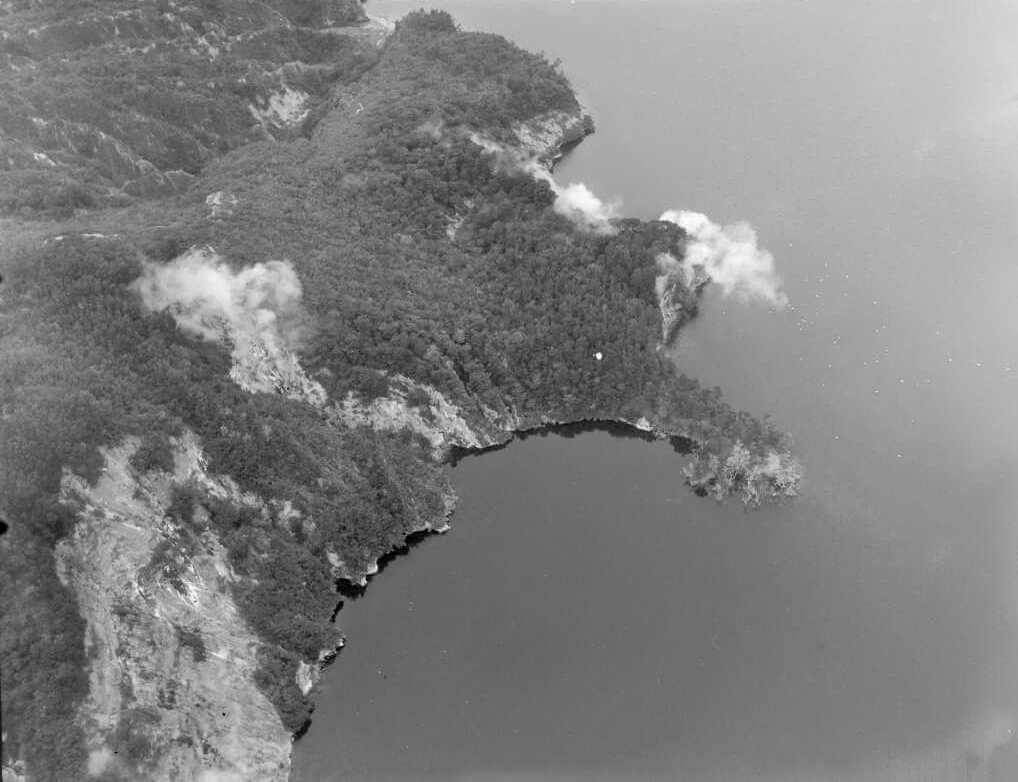
Steaming cliffs, Lake Rotomahana, the crater lake, formed by the eruption of Mount Tarawera in 1886 on the site of the Pink and White Terraces, Bay of Plenty photographed in 1951 by Whites Aviation. Photo: National Library.

Janine Krippner
“There was a violent roaring, lasting four or five minutes at a time… we saw a cloud gradually rising, black as ink… it was flashing with lightning in every direction, while occasionally fireballs, like rockets, dashed from it; the number of these and their vivacity increased to a fearful extent while we were gazing… the wind increased, and we had scarcely reached the house when it began, as we thought, to rain heavily. The windows were smashed in, and we found that what we had taken for rain was scoria and stone.” The “fireballs” noted here were likely pulses of lava as a violent eruption jetted molten rock and gases into the sky above. Experiences go on to describe roofs collapsing from the weight of volcanic ash, intense ground shaking, and lightning even seeming to strike the road in front of one person caught in the eruption. At around 3:20 am the crisis went from bad to worse. The eruption extended underneath a lake with explosions sending heavy mud into the air and down on the surrounding area, and even worse, fast, deadly, pyroclastic surges of scorching steam that raced across the landscape. By 6 am the eruption was over.
This is not from some far-away country, this happened within a couple of hours drive East of Te Awamutu. The 10 June 1886 eruption of Tarawera began at 1:30 am and lasted 4-5 hours, killing around 120 people, mostly Māori from Te Ariki, Moura, Totarariki, Toiniho, and Waitangi, and forcing many more from their homelands. The eye-witness accounts from this relatively short eruption are so good that we can look at the deposits and know what time they were emplaced. This includes reports of people hearing the eruption in Auckland and Blenheim. The event opened a 17-km-long fissure with more than 50 vents and 13 main craters. The hot pyroclastic surges spread out to 6 km from Lake Rotomahana, up and over hilly topography reaching 350 m above the vent. The landscape was drastically changed.
This eruption is unusual in that the magma type was basalt, the type we see forming the runny lava flows in Hawaii. It is not usually explosive, and very rarely this explosive. Tarawera is part of the Okataina caldera complex that extends from Lake Rotoma to Waiotapu, with more than 35 active vents over the past 21,000 years. This latest eruption occurred less than 140 years ago, a very short time for a volcanic system but a long time for humans. Long enough to have many more people inhabiting the area. If you haven’t been already, the Buried Village of Te Wairoa has preserved part of this history for us to see today, where you can try to grasp the horrors that those people experienced. It is important for us to remember the violent past of our lands so that we have the resources and plans in place to prepare for future eruptions. We will have more eruptions. We can’t tell when, or how big. What we do know is that now we have a much larger population, farm animals, infrastructure, technological needs, and an economy to take into account. Because of this, if the 1886 eruption occurred today it would be much, much worse.
- Excerpts from the New Zealand Herald, Volume XXIII, Issue 7664, 15 JUNE 1886, PAGE 6, via Papers Past.









